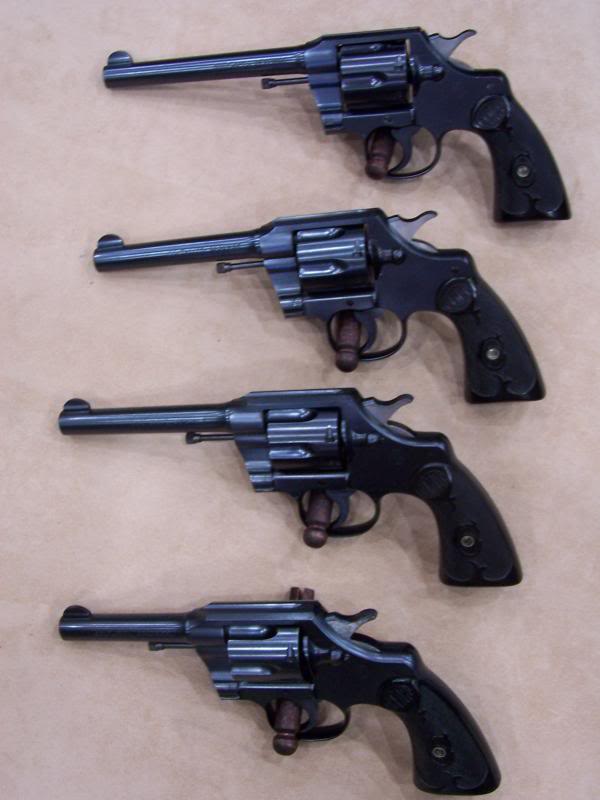There are a number of threads about shooting .38 Special cartridges in a Colt Army Special revolver but no threads I can find that are reasonably current. For what it's worth, the following is not my opinion but rather advice I received in a telephone call from two, currently employed engineers of Colt's, in response to a letter or an email (I disremember which) I sent to the company asking for official information. All this occurred some time ago, in 2003, but I made notes about it.
Background: In Summer of 2003, I bought via Gunbroker from Sauers Trading in Pennsylvania, a blued Colt Army Special made circa 1920, the serial number of which was 455,160. This revolver had a six inch barrel and hard rubber Colt logo grips in nice condition. The barrel's left side rollmark was "COLT .38" with "Army" superimposed over "Special", both in smaller case and the superimposed pair situated between COLT and Army. Which all of us have seen as the usual rollmark for a .38 caliber Army Special. I do not recall whether the cylinder charge holes were milled with bullet seats - that is to say, whether the cylinder was bored straight through, but the cylinder was long enough to fully chamber a .38 Special length cartridge but not a .357 magnum cartridge.
To my surprise, several weeks after I wrote, I got a telephone call from Colt's, with not just one but TWO engineers on the line, to answer the questions I had posed. Here is what they told me:
1. The Army Special was never chambered for the .38 Special cartridge. The "Special" in the rollmark referred to the name of the revolver itself, not to the cartridge for which it was chambered. The only thirty eight caliber cartridge for which the Army Special was ever designed was the .38 Long Colt cartridge, which of course could also include the Short version of the cartridge.
2. The specifications and processes used during the entire period of manufacture of the Army Special did not specify cylinder length to be a critical dimension and some Army Specials produced would even chamber a 357 magnum cartridge.
3. The specified groove diameters of the barrel at breech and muzzle were .353 to .354. The specified bore diameters at breech and muzzle were.346 to .347.
4. Colt's advised strongly against shooting 38 Special cartridges in any Army Special.
This advice obviously contradicts what some other sources have said and I don't know what the truth is. It may be that by the time the Army Special became the Official Police, which was catalogued from the beginning for the .38 Special, the late production Army Specials were identical in strength. Metallurgy was not static during the Army Special's years of production. In any event, this information is the closest to "out of the horse's mouth" that I know of. Without access to original factory design and production documents and change orders, or someone's willingness to subject his Army Special to destructive testing, I don't know how to prove or disprove the issue.
Background: In Summer of 2003, I bought via Gunbroker from Sauers Trading in Pennsylvania, a blued Colt Army Special made circa 1920, the serial number of which was 455,160. This revolver had a six inch barrel and hard rubber Colt logo grips in nice condition. The barrel's left side rollmark was "COLT .38" with "Army" superimposed over "Special", both in smaller case and the superimposed pair situated between COLT and Army. Which all of us have seen as the usual rollmark for a .38 caliber Army Special. I do not recall whether the cylinder charge holes were milled with bullet seats - that is to say, whether the cylinder was bored straight through, but the cylinder was long enough to fully chamber a .38 Special length cartridge but not a .357 magnum cartridge.
To my surprise, several weeks after I wrote, I got a telephone call from Colt's, with not just one but TWO engineers on the line, to answer the questions I had posed. Here is what they told me:
1. The Army Special was never chambered for the .38 Special cartridge. The "Special" in the rollmark referred to the name of the revolver itself, not to the cartridge for which it was chambered. The only thirty eight caliber cartridge for which the Army Special was ever designed was the .38 Long Colt cartridge, which of course could also include the Short version of the cartridge.
2. The specifications and processes used during the entire period of manufacture of the Army Special did not specify cylinder length to be a critical dimension and some Army Specials produced would even chamber a 357 magnum cartridge.
3. The specified groove diameters of the barrel at breech and muzzle were .353 to .354. The specified bore diameters at breech and muzzle were.346 to .347.
4. Colt's advised strongly against shooting 38 Special cartridges in any Army Special.
This advice obviously contradicts what some other sources have said and I don't know what the truth is. It may be that by the time the Army Special became the Official Police, which was catalogued from the beginning for the .38 Special, the late production Army Specials were identical in strength. Metallurgy was not static during the Army Special's years of production. In any event, this information is the closest to "out of the horse's mouth" that I know of. Without access to original factory design and production documents and change orders, or someone's willingness to subject his Army Special to destructive testing, I don't know how to prove or disprove the issue.








